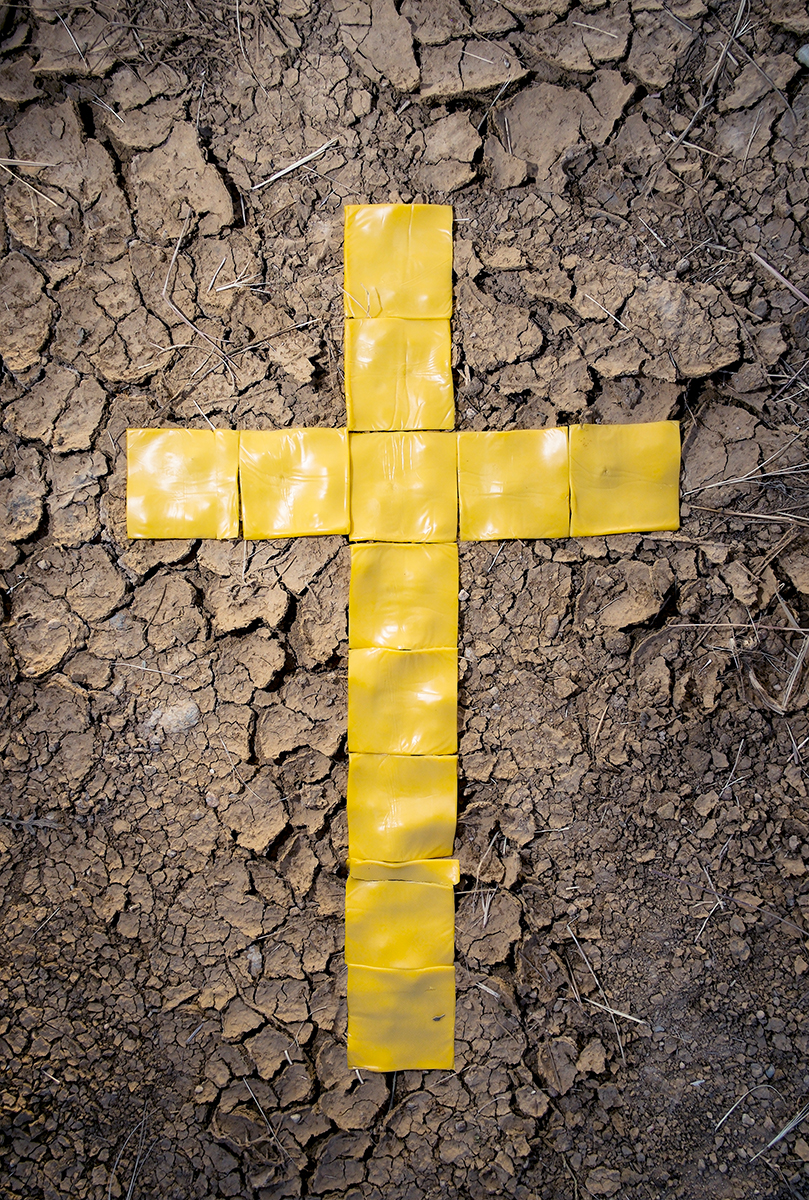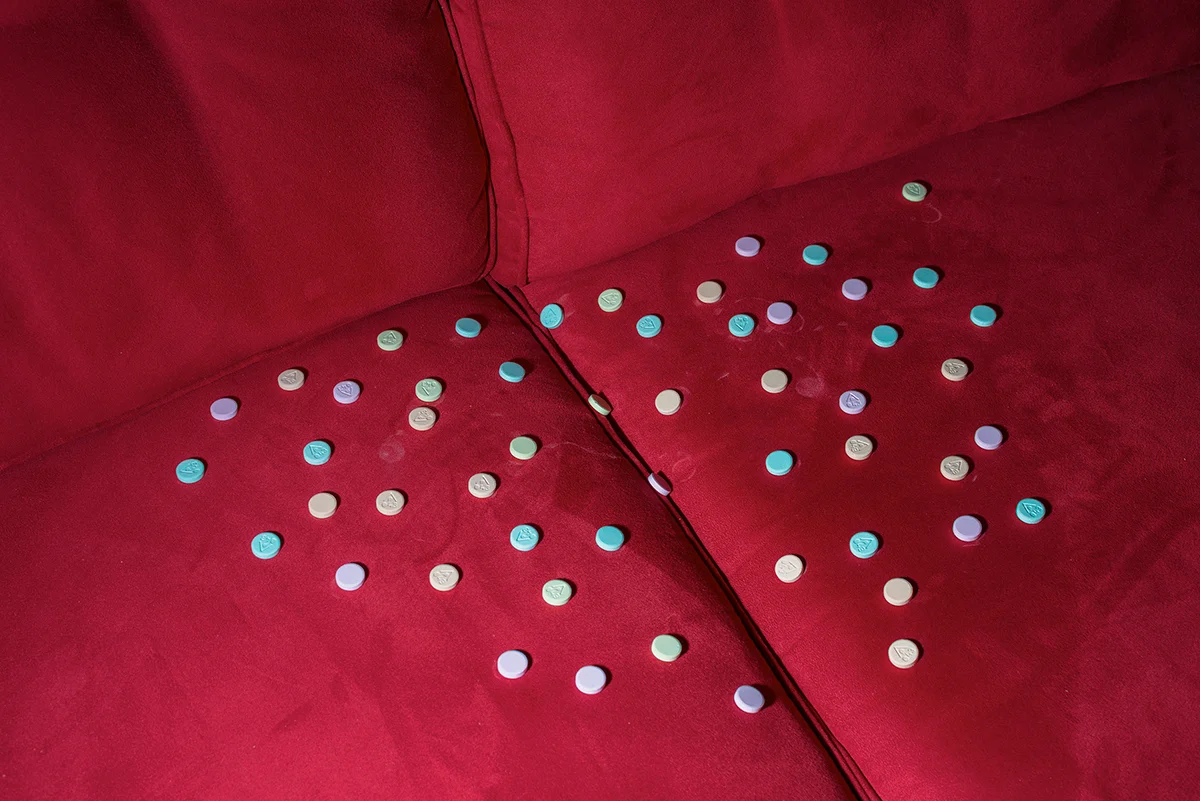© Maury Gortemiller
A new photography book combines religious kitsch, southern mythology, and eerie occult horror.
A crucifix made from Kraft cheese slices sitting on a dirt road. Poltergeist-y mist coming seeping through a sunlit door. Two bedsheet ghosts driving a car. These are just a few of the funny and strange photos included in Maury Gortemiller’s new book Do The Priest in Different Voices, a collection of images inspired by the photographers’ bible-heavy childhood memories. Growing up, religious illustrations helped him conjure the unseen and make the Bible’s written words – which felt abstract and inaccessible – feel tangible, palatable and worth contemplation.
Gortemiller’s work is a peculiar, contemporary take on these narratives, often infused with mythology from the American South where he grew up and currently lives and works. We spoke to discuss everything from the project’s origins to Gortemiller's relationship with religion and his love for horror movies.
Maury Gortemiller in conversation with Jon Feinstein
© Maury Gortemiller
Jon Feinstein: Your title “Do The Priest in Different Voices” makes me uneasy yet draws me in. What’s the story behind it?
Maury Gortemiller: It refers to an early working title for T.S. Eliot’s long poem "The Waste Land," which was “He Do the Police in Different Voices.” That’s actually a line from the Charles Dickens novel Our Mutual Friend. In the book, a Mrs. Higden cares for orphaned children. Two prospective foster parents visit her and express an interest in a young man named Sloppy, one of her wards. 'For I aint, you must know,' said Betty, 'much of a hand at reading writing-hand, though I can read my Bible and most print. And I do love a newspaper. You mightn't think it, but Sloppy is a beautiful reader of a newspaper. He do the Police in different voices.' Sloppy then throws back his head, "extended his mouth to its utmost width, and laughed loud and long. At this the two innocents, with their brains in that apparent danger, laughed, and Mrs Higden laughed, and the orphan laughed, and then the visitors laughed."
Feinstein: Woah. How do your images play off of this?
Gortemiller: I’m attracted to Eliot’s mix of satire and prophecy, and his juxtaposition of the sacred and the profane. For example, I like his pairing of bar patrons talking about the things people talk about at closing time, paired with the words of a sybil, a prophetess from Ancient Greece who uttered divine revelations in a frenzied state. I don’t feel that any of my images are satirical, but I am holding at a distance things and ideas that many people revere. And at the same time, I’m interested in the possibility of coming to terms with experience in a way that has little to do with science or organized religion or conventional notions of western spirituality.
© Maury Gortemiller
Feinstein: How did the project itself start?
Gortemiller: Probably with the image “Then They Took the Body and Wound It in Linen Cloths with Spices," or what I call the “Golden Ghost” image (above). The shoot took place outside of a large subdivision at the northwest edge of the Houston, Texas, metro area. The image is a re-imagining of the Pieta form. The objects include a gold tablecloth, a large stuffed animal (rabbit), light stand and finally a mobile basketball goal. The post of the latter was adjusted to an extreme angle and telescoped as far as possible. I wanted to emphasize a triangular shape and the billowing drapery of Mary’s attire.
While it has a decidedly fantastical approach, I locate a symbol of suffering and hope for so many in a quiet and particularly unspectacular setting. The golden form is only a tablecloth over a stuffed rabbit of course, but it’s informed by the wind in such a way that suggests an otherness appearing from nowhere. For me, the shape suggests notions of divination and prophecy. I’m interested in the possibility of omens and portents, not to predict the future or ensure success, but more simply as an alternate way of knowing and ordering experience.
© Maury Gortemiller
Feinstein: In your statement you write “It is the pictures I remember – not the words.” - can you elaborate on this? What are some early images you recall from reading the bible as a child?
Gortemiller: Specifically, I remember "Creation of Man" by Giordano and Raphael's Transfiguration." Thinking about God and religion for me was a visual experience. The stories and moral lessons left little impression upon me. Instead, it was the depiction of the supernatural via an illustrated bible which was transfixing. The possibility of an unseen world presided over by an omnipotent being, in which destruction always seemed to be imminent - this was very real and harrowing to me only as deployed in the paintings. Maybe this was the influence of comic books or the recent and much-welcomed arrival of cable television in our house and other houses across the neighborhood.
At any rate, I began to think that any sort of existence of God or of a higher power would, at times, be made most clear in the physical world as some kind of visual embodiment of the supernatural. And these signs would be all the more compelling and poignant when recognized in the most ordinary and pedestrian of circumstances.
© Maury Gortemiller
Feinstein: The cheese cross photo has stood out for me for years. It’s funny, weird and a little scary. What’s the story behind it?
Gortemiller: This was also one of the earlier images created for the series. My mother had just moved to the area that I mentioned above, and I was fortunate to be able to spend a few months with her. Her street was at the edge of the subdivision at that time, and to the northwest lay the remaining acreage yet to be developed. It was not uncommon to see the occasional renegade cow wandering the street, having just escaped from a neighboring farm.
This liminal area was great for kicking around and looking for, staging photographs. Just beyond a dead end street, I threw down the cheese slices on caked mud. I was drawn to the juxtaposition of the cheese squares with the irregular shapes of the mud cracks. I used a wide angle lens which you can clearly see if you look closely. I soon remade the image using a ladder and a longer focal length lens - a flatter image seemed appropriate. However, I grew to prefer the distortion produced by the wider lens; the "falling away" of the earth at the corners, and also the vignette effect, lends a slight bit of spatial depth to the image plane.
Feinstein: I have a feeling you’re a big horror movie fan…
Gortemiller: I am - all kinds, really. I earlier mentioned the impact of comic books and cable television. Maybe my recollections of reading the bible are twinned in some way with media culture - I mean, it's hard to identify an element of my life - then or now - that isn't informed by exposure to media in some way. Perhaps the supernatural imagery of the paintings was aligned with horror movies in my young mind. It's certainly possible that I turned to the bible illustrations after watching "Poltergeist" for the umpteenth time.
© Maury Gortemiller
© Maury Gortemiller
Feinstein: I had the pleasure of seeing some of these in person at the Ogden back in December. Aside from you being based in GA, is there something else that makes them particularly “southern”?
Gortemiller: The particular strain of Christianity that I had in mind in creating these images is the Southern Baptist denomination - simply because that's what was so prevalent in my youth. Of course, considering faith on a personal level is not limited to region or country. However, in certain parts of the country, perhaps the pressure to conform and worship in a prescribed, social and visible manner is more pronounced, more of a seemingly inherent element of culture.
Feinstein: There’s a level of crafting or staging to many of these images. What’s your process look like for making a photo?
Gortemiller: In general, much of my work is generated by taking a camera wherever I might roam on a daily basis. This series allowed the opportunity to deliberately stage subjects in terms of crafting or suggesting narrative. Sometimes that staging is accomplished optically before the camera as referenced earlier; at other times I digitally alter the images. I particularly enjoy when the optical staging might appear to be digitally accomplished and vice versa. That sort of duality of wondering what is "real" or "fake," or intended or accidental, is an inherent element of any photograph. Not necessarily in regard to process, but more so in regard to intention and content, and the gap between what the maker thinks he/she is creating and what the viewer sees and resolves.
© Maury Gortemiller
© Maury Gortemiller
Feinstein: Has making these images changed your childhood memories or ideas about religion?
Gortemiller: I wouldn't say the series has changed or altered my childhood memories or how I consider them. I also don't feel like working with the images has altered my ideas about traditional religions or religious narratives about which I've always been a bit skeptical. However, working on the project has awakened in me a thirst for spirituality. I find myself venturing towards concepts of Eastern religions, including the healthful spiritual aspects of meditation.









